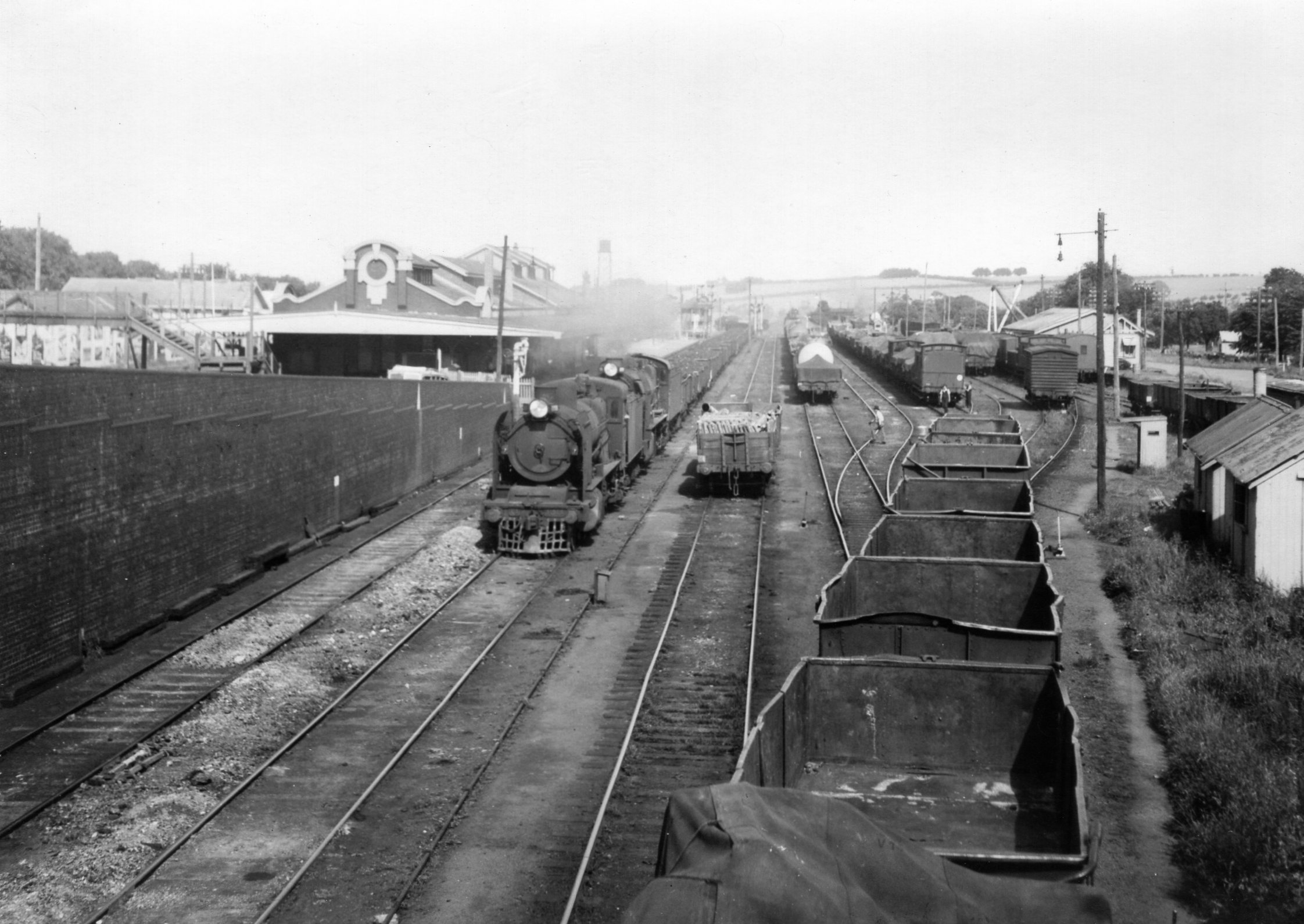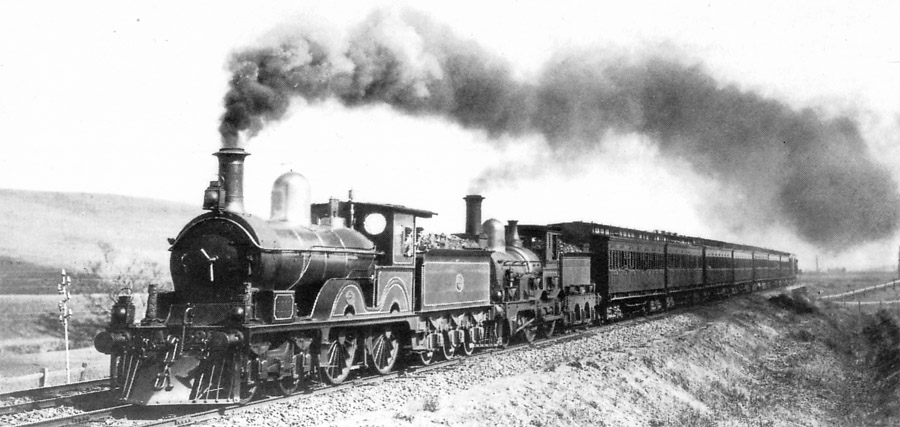|
N Type Carriage
The N type carriages are an intercity passenger carriage used on the railways of Victoria, Australia. They were introduced between 1981 and 1984 as part of the 'New Deal' reforms of country passenger rail services. Today they are seen on both V/Line long distance InterCity services, and limited commuter services to Geelong. The carriage sets have both first class 2+2 seating, and 2+3 economy seating. Snack bar facilities are also provided on board. Originally delivered as three-car sets, some sets were extended in length with S and Z type carriages. Today the carriages are hauled by N class diesel locomotives. The carriages can use an external head end power supply for lighting and air conditioning operation. Each carriage has two swing doors per side, which were originally manually opened by passengers, but have since been converted to powered operation, and they are locked or unlocked by the conductor. Toilets, drinking fountains and luggage areas are provided throughout e ... [...More Info...] [...Related Items...] OR: [Wikipedia] [Google] [Baidu] |
Newport Workshops
The Newport Railway Workshops is a facility in the Melbourne suburb of Newport, Victoria, Newport, Australia, that builds, maintains and refurbishes Rolling stock, railway rollingstock. It is located between the Williamstown railway line, Williamstown and Werribee railway lines. History Plans for a workshop at Newport started in the 1860s, to replace the temporary Williamstown Workshops but nothing came of it. It was not until 1880 that work began, when the Victorian Railways purchased annexes used at the Melbourne International Exhibition (1880), 1880 Melbourne Exhibition and erected one of them at Newport, naming it the Newport Carriage Workshops when it began operation in 1882. Construction of the permanent workshops commenced in 1884, and was completed in 1889. Although the earlier carriage workshop closed at this time, it reopened in 1895 to manufacture signal equipment. The first Railroad car, carriages built by the workshops were completed in 1889, but locomotives were ma ... [...More Info...] [...Related Items...] OR: [Wikipedia] [Google] [Baidu] |
V/Line N Class (diesel)
The N Class are a class of diesel locomotives built by Clyde Engineering, Somerton for V/Line between 1985 and 1987. History By the start of the 1980s, Victorian Railways passenger numbers had fallen to around 3 million per year, due to ageing rolling stock, stagnant timetables and competition from other forms of transport. The Lonie Report of 1980 recommended cuts to the network, with the general public responding by calling for the State Government to maintain a viable rail network. The government response in February 1981 was the ''New Deal for Country Passengers'', a $115 million commitment to recast country rail passenger services in Victoria. As part of the ''New Deal'', all B class locomotives were to be re-built as the A class for use on passenger services and ten new locomotives ordered. Tenders closed in 1983 for the first 10 units, with Clyde Engineering being awarded the contract. By mid-1985, the rising cost of the A class conversions saw the project aban ... [...More Info...] [...Related Items...] OR: [Wikipedia] [Google] [Baidu] |
Swan Hill Railway Station
Swan Hill railway station is located on the Piangil line in Victoria, Australia. It serves the town of Swan Hill, and it opened on 30 May 1890.Swan Hill Vicsig The station serves as the current for V/Line's Swan Hill line services. Beyond the station, and |
Bendigo Railway Line
The Deniliquin railway line (also known as the Echuca railway line) is a broad-gauge railway line serving northwestern Victoria, Australia. The line runs from the border settlement of Deniliquin into Bendigo, before turning south-southeast towards Melbourne, terminating in Docklands near the central business district. It is a major trunk line both for passenger and freight trains, with many railway lines branching off from it. History The Company Construction of the line was begun by the Melbourne, Mount Alexander and Murray River Railway Company, which was incorporated in 1852. The first thirteen sections of the line were constructed by contractors Cornish and Bruce, who gained a reputation for trying to reduce costs by taking shortcuts on materials and reducing worker's wages. The company made almost no progress on the construction of the railway due to an inability to raise sufficient funds, and in 1856 it was purchased by the Victorian Government. Because Isambard Kingdom ... [...More Info...] [...Related Items...] OR: [Wikipedia] [Google] [Baidu] |
Bairnsdale Railway Station
Bairnsdale railway station is the terminus of the Gippsland line in Victoria, Australia. It serves the city of Bairnsdale, and it opened on 8 May 1888.Bairnsdale Vicsig Until 1987, the line continued to . This has been redeveloped as the , a shared bicycle, walking, and horse-riding track. History The railway line opened to Bairnsdale in 1888, and from 1916, continued through to |
Gippsland Railway Line
The Gippsland line (also known as the Orbost railway line) is a railway line serving the Latrobe Valley and Gippsland regions of Victoria (Australia), Victoria, Australia. It runs east from the state capital Melbourne through the cities of Moe, Victoria, Moe, Morwell, Victoria, Morwell, Traralgon, Victoria, Traralgon, Sale, Victoria, Sale and terminating at Bairnsdale, Victoria, Bairnsdale. Prior to its dismantling in 1994, the line extended to Orbost, Victoria, Orbost. The dismantled section now comprises the East Gippsland Rail Trail, a shared bicycle, walking, and horseriding track. Services Metro Trains Melbourne operates suburban passenger services along the inner section of the line as the Pakenham railway line, Pakenham line, while V/Line services operate as the Traralgon V/Line rail service, Traralgon and the Bairnsdale V/Line rail service, Bairnsdale lines. Freight services also use the line, operated by Qube Holdings. History Rail lines were built to Gippsland ... [...More Info...] [...Related Items...] OR: [Wikipedia] [Google] [Baidu] |
Shepparton Railway Station
Shepparton railway station is located on the Tocumwal line in Victoria, Australia. It serves the city of Shepparton, and it opened on 13 January 1880.Shepparton Vicsig It is the terminus for services from . A 725 metre long is located opposite the station. The station opened as a temporary terminus of the line from |
North East Railway Line
The North East railway line is a railway line in Victoria, Australia. The line runs from Albury railway station in the border settlement of Albury–Wodonga to Southern Cross railway station on the western edge of the Melbourne central business district, serving the cities of Wangaratta and Seymour, and smaller towns in northeastern Victoria. The line is owned by VicTrack, but leased to, and maintained by, the Australian Rail Track Corporation, and forms part of the Sydney–Melbourne rail corridor. Unlike most other heavy rail lines in Victoria, the line is completely standard gauge, after works were carried out between 2008 and 2010. However, the broad gauge Tocumwal line runs parallel to the line between Seymour and Broadmeadows. History The Melbourne and Essendon Railway Company opened the first section of the Albury line, from North Melbourne to Essendon, in 1860. Following its takeover by the Victorian Government in 1867, the line was extended by 1872 to S ... [...More Info...] [...Related Items...] OR: [Wikipedia] [Google] [Baidu] |
Standard Gauge
A standard-gauge railway is a railway with a track gauge of . The standard gauge is also called Stephenson gauge (after George Stephenson), International gauge, UIC gauge, uniform gauge, normal gauge and European gauge in Europe, and SGR in East Africa. It is the most widely used track gauge around the world, with approximately 55% of the lines in the world using it. All high-speed rail lines use standard gauge except those in Russia, Finland, and Uzbekistan. The distance between the inside edges of the rails is defined to be 1435 mm except in the United States and on some heritage British lines, where it is defined in U.S. customary/Imperial units as exactly "four feet eight and one half inches" which is equivalent to 1435.1mm. History As railways developed and expanded, one of the key issues was the track gauge (the distance, or width, between the inner sides of the rails) to be used. Different railways used different gauges, and where rails of different gauge met – ... [...More Info...] [...Related Items...] OR: [Wikipedia] [Google] [Baidu] |
Albury V/Line Rail Service
The Albury line is a regional passenger rail service operated by V/Line in Victoria, Australia. It serves passengers between state capital Melbourne and the regional cities of Benalla, Wangaratta, Wodonga, and the NSW border city of Albury. History After February 2008, train services on the line terminated at Wangaratta station, with road coaches operating from Wangaratta to Albury. This was due to the deteriorating track conditions between Seymour and Albury which were resulting in train speeds being reduced from , and trains not being able to make the return journey in the timetabled period. On 30 May 2008, the then Premier of Victoria John Brumby announced the broad gauge track between Seymour and Albury would be converted to standard gauge, with the project to be combined with the Wodonga Rail Bypass away from the Wodonga CBD. Three V/Line passenger locomotives and 15 passenger carriages were also to be converted to standard gauge to operate the service. Although the projec ... [...More Info...] [...Related Items...] OR: [Wikipedia] [Google] [Baidu] |
V/Line Sprinter
The Sprinter is a diesel railcar built by A Goninan & Co in Broadmeadow, NSW for V/Line between 1993 and 1995. Design origins The Sprinter concept dates back to 1989, when the Public Transport Corporation, having seen a substantial increase in patronage and reduction in costs following the introduction of faster, more frequent services as part of the New Deal for Country Passengers program of the 1980s, required additional train capacity to meet demand. Initial talks suggested an order for 24 new vehicles, though the tenders for the construction of the 22 railcars closed in November 1989. At the time they were designed to supplement locomotive-hauled H type carriage sets on shorter runs (such as on the outer suburban Melton and Sunbury lines, as well as the interurban Geelong and Seymour lines) and thus provide faster and more frequent service to Melbourne's fringe areas, and indirectly (primarily by freeing up other rollingstock) to more distant regions. Their introducti ... [...More Info...] [...Related Items...] OR: [Wikipedia] [Google] [Baidu] |
H Type Carriage
The H type carriages are a class of interurban passenger carriage operated by V/Line in Victoria, Australia. Fitted with high-density 2+3 seating, they are typically used on short distance interurban services from Melbourne to Bacchus Marsh and Geelong. Overview By 1983, the 1981 New Deal had been such a success that the incoming Cain Government ordered conversion of a fleet of the early Harris suburban Electric Multiple Units to replace the last of the older wooden carriage stock. The fleet eventually reached 59 carriages of multiple types. For the purpose of contract negotiations, short cars were referred to as SCH, SH or STH and long as LCH, LH or LTH, respectively for conductor, regular and terminal carriages. Each carriage has two doors per side, manually opened by passengers, but remotely closed and locked by the train conductor. Toilets, drinking fountains and luggage areas are provided throughout each carriage set. The carriage sets were originally used for comm ... [...More Info...] [...Related Items...] OR: [Wikipedia] [Google] [Baidu] |





